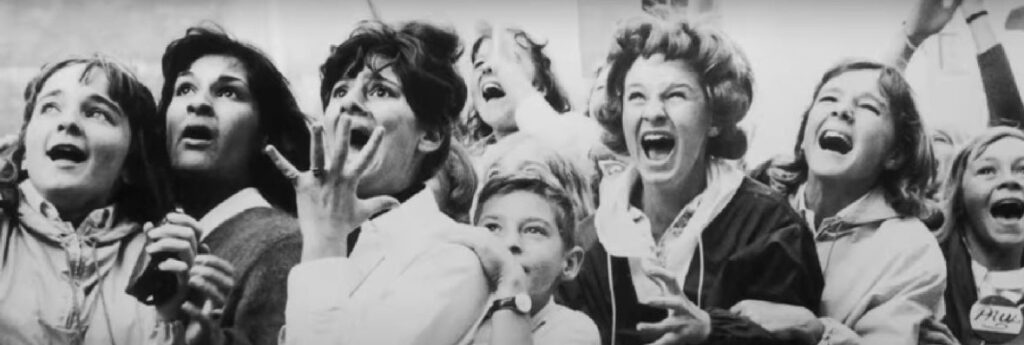The phenomenon of Beatlemania screamed itself into existence 60 years ago in October 1963. Sixty years later, Liverpool’s The Beatles Story has released a new video that explores the phenomenon with first-hand accounts of those frantic fanatical days.
The museum/attraction, located on the city’s historic waterfront, uncovers the accounts of Fab Four insiders/observers Beryl Marsden, Freda Kelly, Bernadette Byrne, Dr Mike Brocken, Dr Kitty Oliver, and Skylar Moody, and attempts to answer the questions: Where did Beatlemania come from? Is Beatlemania still alive? What is the legacy of Beatlemania?
In 1962 Bernadette Byrne, George Harrison’s then girlfriend and co-founder of The Beatles Story, was in a car with George being driven away from a gig at the Floral Hall in Southport. The car was being mobbed and chased by young fans, an experience described by Byrne as “terrifying.” What she saw that night was the beginning of a phenomenon that would shape the next 60 years of pop culture, a phenomenon that was later coined “Beatlemania.”
“It was a scream. It didn’t stop” – Beryl Marsden
For most of 1963 there had been reports of teenage girls screaming, crying, and fainting with excitement at Beatles gigs. On 13th October 1963 this phenomenon was catapulted into the public eye when The Beatles played the popular ITV show “Sunday Night at the Palladium.” It would be this performance to a TV audience of 15 million viewers that would help define the word “Beatlemania.”
Though the reviews for the performance were positive it wasn’t The Beatles’ performance that made headlines. It was, instead, the reactions of the audience, with their passionate screaming, that caught the attention of the press. The band were hardly even able to hear themselves under the constant screaming of the audience!
“They were so excited of seeing them on stage, they just had to release the tension by screaming” – Freda Kelly
Eight days later on Oct. 21 was the first documented use of the term “Beatlemania” when Daily Mail journalist Vincent Mulchrone wrote an article under the headline “This Beatlemania” in response to the performance at the London Palladium and the growing reports of screaming fans.
Andi Lothian, a Scottish concert promoter, maintains however that he coined the term at a Beatles performance on Oct. 5 at the Glasgow Odeon. When asked by a reporter to explain what was happening at the gig as a group of girls rushed the stage he reportedly said: “That’s Beatlemania.”
Whatever its origin, the term was here to stay and by Feb. 7, 1964, when The Beatles arrived at JFK Airport to thousands of screaming fans, the term was firmly cemented into popular culture.
“I would say it was very liberating for young girls, who then become the liberated young women of the 1970s” – Dr. Mike Brocken
The legacy of Beatlemania had a profound impact on the world. Dr Kitty Oliver’s first concert was seeing The Beatles at The Gator Bowl in Florida, when a new page was turning with respect to segregation and civil rights in the US. Her time at this concert was her first experience being around white people, where she and them were united by their love of The Beatles.
“Beatlemania was transformational, a cracking open of the old traditions of what music could be like and how music could influence people” – Dr Kitty Oliver
Beatlemania, arguably, still lives on today. Beatles’ fan clubs gave way to social media fan accounts, and autographs gave way to selfies. Though the way in which Beatlemaniacs show their love for the world’s greatest band looks quite different now to how it did in the 1960s, that same love and passion for The Beatles remains.
“For the most part, 99% of people from the Beatlemania era are always so welcoming for the new generations, because they want that torch to be passed down” – Skylar Moody
The Beatles Story
The award-winning ‘The Beatles Story’ is the world’s largest permanent exhibition purely devoted to telling the story of The Beatles’ rise to fame and the musical heritage of Liverpool. The collection of memorabilia ranges from George Harrison’s first guitar to John Lennon’s last piano. The story is told through complimentary ‘Living History’ audio guides, available in 12 different languages.

